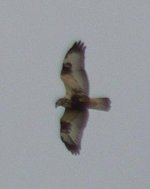Macswede
Macswede
These pictures vary in quality from not too bad to really awful. They were all taken in the south of Sweden yesterday (5/11).
The harriers I was able to identify during my stay in the south were all Hen Harriers but I'm not sure about the one here.
I'm pretty sure I know what the second picture is but I'd like confirmation as I've only seen this species once previously in the field. There were 3 of them and they made the Buzzards in the vicinity look relatively small and were bulky compared to the Red Kites. (This was at Fyledalen one of the best raptor sites in Sweden.)
The final 2 are just in case any of you want to amuse yourselves by ID-ing terrible pictures. I've already received confirmation on both of them.
Very grateful for any input.
Graham
The harriers I was able to identify during my stay in the south were all Hen Harriers but I'm not sure about the one here.
I'm pretty sure I know what the second picture is but I'd like confirmation as I've only seen this species once previously in the field. There were 3 of them and they made the Buzzards in the vicinity look relatively small and were bulky compared to the Red Kites. (This was at Fyledalen one of the best raptor sites in Sweden.)
The final 2 are just in case any of you want to amuse yourselves by ID-ing terrible pictures. I've already received confirmation on both of them.
Very grateful for any input.
Graham












